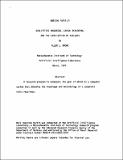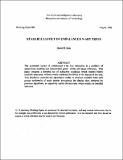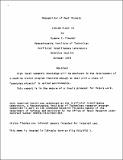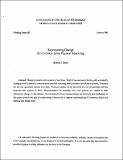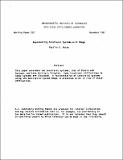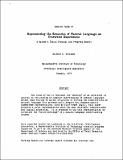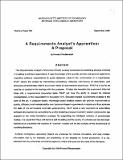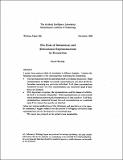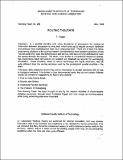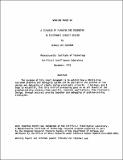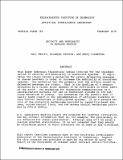Browsing AI Working Papers (1971 - 1995) by Title
Now showing items 200-219 of 291
-
Qualitative Knowledge, Causal Reasoning, and the Localization of Failures
(MIT Artificial Intelligence Laboratory, 1974-03)A research program is proposed, the goal of which is a computer system that embodies the knowledge and methodology of a competent radio repairman. -
Quantitative Aspects of the Computation Performed by Visual Cortex in the Cat, With a Note on a Function of Lateral Inhibition
(MIT Artificial Intelligence Laboratory, 1973-12)A quantitative summary is given of the computation that is performed by visual cortex in the cat. Part of this computation seems to be achieved using a sample-and-average technique; some quantitative features of this ... -
Rational Arithmetic For Mini-Computers
(MIT Artificial Intelligence Laboratory, 1977-09)A representation for numbers using two computer words is discussed, where the value represented is the ratio of the corresponding integers. This allows for better dynamic range and relative accuracy than single-precision ... -
Readable Layout of Unbalanced N-ary Trees
(MIT Artificial Intelligence Laboratory, 1986-08)The automatic layout of unbounded n-ary tree structures is a problem of subjectively meshing two independent goals: clarity and space efficiency. This paper presents a minimal set of subjective aesthetics which insures ... -
-
Recognition of Real Objects
(MIT Artificial Intelligence Laboratory, 1972-10)High level semantic knowledge will be employed in the development of a machine vision program flexible enough to deal with a class of "everyday objects" in varied environments. This report is in the nature of a thesis ... -
Report on the Second Workshop on Distributed AI
(MIT Artificial Intelligence Laboratory, 1982-01)On June 24, 1981 twenty-five participants from organizations around the country gathered in MIT's Endicott House for the Second Annual Workshop on Distributed AI. The three-day workshop was designed as an informal meeting, ... -
Report on the Workshop on Distributed AI
(MIT Artificial Intelligence Laboratory, 1980-09)On June 9-11, 22 people gathered at Endicott House for the first workshop on the newly emerging topic of Distributed AI. They came with a wide range of views on the topic, and indeed a wide range of views of what precisely ... -
Reporter: An Intelligent Noticer
(MIT Artificial Intelligence Laboratory, 1977-11-15)Some researchers, notably Schank and Abelson, (1975) have argued for the existence of large numbers of scripts as a representation for complex events. This paper adopts a different viewpoint. I consider complex events to ... -
Representing Change for Common-Sense Physical Reasoning
(MIT Artificial Intelligence Laboratory, 1983-01)Change pervades every moment of our lives. Much of our success in dealing with a constantly changing world is based in common-sense physical reasoning about processes and physical systems. Processes are the way quantities ... -
Representing Constraint Systems with Omega
(1981-11)This paper considers two constraint systems, that of Steele and Sussman, and Alan Borning's Thinglab. Some functional difficulties in these systems are discussed. A representation of constraint systems using the description ... -
Representing the Semantics of Natural Language as Constraint Expressions
(MIT Artificial Intelligence Laboratory, 1975-01)The issue of how to represent the "meaning" of an utterance is central to the problem of computer understanding of natural language. Rather than relying on ad-hoc structures or forcing the complexities of natural language ... -
A Requirements Analyst's Apprentice: A Proposal
(MIT Artificial Intelligence Laboratory, 1986-09)The Requirements Analyst's APprentice (RAAP) partially automates the modeling process involved in creating a software requirement. It uses knowledge of the specific domain and general experience regarding software requirements ... -
Resolving Visual Ambiguity with a Probe
(MIT Artificial Intelligence Laboratory, 1971-07)The eye-hand robot at the Artificial Intelligence Laboratory now possesses the ability to occasionally copy simple configurations of blocks, using spare parts about whose presence it knows. One problem with which it cannot ... -
Review of Human Vision Facts
(MIT Artificial Intelligence Laboratory, 1973-03-20)This note is a collection of well known interesting facts about human vision. All parameters are approximate. Some may be wrong. There are sections on retina physiology, eye optics, light adaptation, psychological curios, ... -
The Role of Intensional and Extensional Representations in Simulation
(MIT Artificial Intelligence Laboratory, 1984-12)I review three systems which do simulation in different domains. I observe the following commonality in the representations underlying the simulations: • The representations used for individuals tend to be domain-dependent. ... -
Routing Thoughts
(MIT Artificial Intelligence Laboratory, 1984-05)In a parallel machine with many thousands of processors the routing of information between processors is a key task, which turns out to require as much hardware and perhaps more sophistication than local computing itself. ... -
A scenario of Planning and Debugging in Electronic Circuit Design
(MIT Artificial Intelligence Laboratory, 1973-12)The purpose of this short document is to exhibit how a HACKER-like top-down planning and debugging system can be applied to the problem of the design and debugging of simple analog electronic circuits. I believe, and I ... -
Security and Modularity in Message Passing
(MIT Artificial Intelligence Laboratory, 1979-02)This paper addresses theoretical issues involved for the implementation of security and modularity in concurrent systems. It explicates the theory behind a mechanism for safely delegating messages to shared handlers in ... -
The Semantic Component of PAL: The Personal Assistant Language Understanding Program
(MIT Artificial Intelligence Laboratory, 1977-03)This paper summarizes the design and implementation of the "semantics" module of a natural language undertanding system for the personal assistant domain. This module includes mappings to deep frames, noun phrase referencing ...

